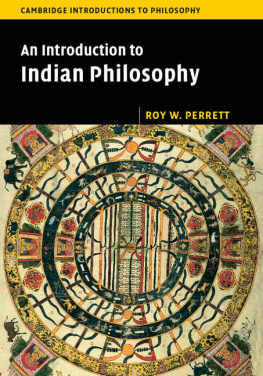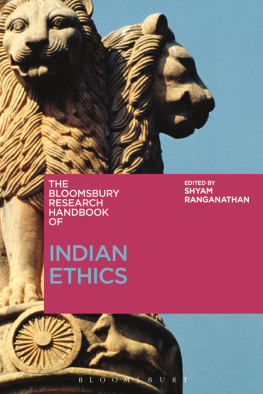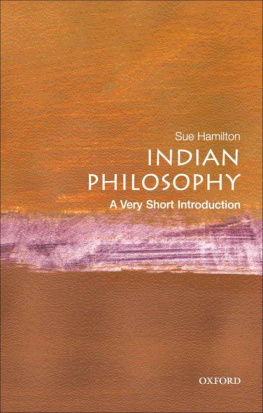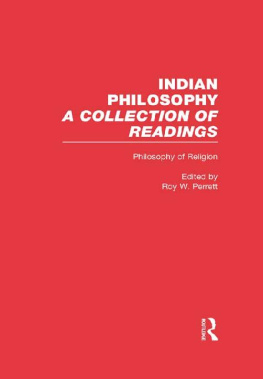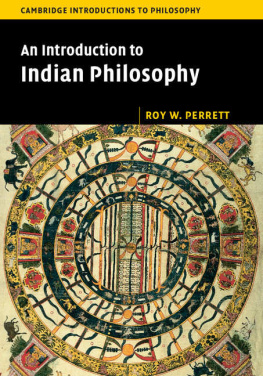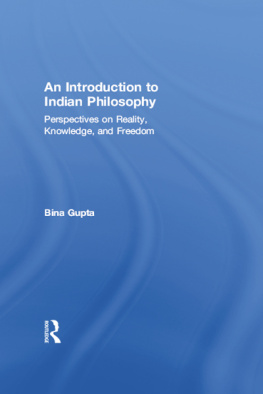An Introduction to Indian Philosophy
This wide-ranging introduction to classical Indian philosophy is philosophically rigorous without being too technical for beginners. Through detailed explorations of the full range of Indian philosophical concerns, including some metaphilosophical issues, it provides readers with non-Western perspectives on central areas of philosophy, including epistemology, logic, metaphysics, ethics, philosophy of language, and philosophy of religion. Chapters are structured thematically, with each including suggestions for further reading. This provides readers with an informed overview, whilst enabling them to focus on particular topics if needed. Translated Sanskrit texts are accompanied by authorial explanations and contextualizations, giving the reader an understanding of the argumentative context and philosophical style of Indian texts. A detailed glossary and a guide to Sanskrit pronunciation equip readers with the tools needed for reading and understanding Sanskrit terms and names. The book will be an essential resource for both beginners and advanced students of philosophy and Asian studies.
ROY W. PERRETT is a Research Associate of the School of Historical and Philosophical Studies at the University of Melbourne, Australia. He is the author of Hindu Ethics: A Philosophical Study (1998) and Death and Immortality (1987).
An Introduction to Indian Philosophy
Roy W. Perrett

University Printing House, Cambridge CB2 8BS, United Kingdom
Cambridge University Press is part of the University of Cambridge.
It furthers the University's mission by disseminating knowledge in the pursuit of education, learning and research at the highest international levels of excellence.
www.cambridge.org
Information on this title: www.cambridge.org/9780521618694
Roy W. Perrett 2016
This publication is in copyright. Subject to statutory exception and to the provisions of relevant collective licensing agreements, no reproduction of any part may take place without the written permission of Cambridge University Press.
First published 2016
Printed in the United Kingdom by Clays, St Ives plc
A catalogue record for this publication is available from the British Library
ISBN 978-0-521-85356-9 Hardback
ISBN 978-0-521-61869-4 Paperback
Cambridge University Press has no responsibility for the persistence or accuracy of URLs for external or third-party internet websites referred to in this publication, and does not guarantee that any content on such websites is, or will remain, accurate or appropriate.
An old style can be translated, as it were, into a newer language; it can, one might say, be performed afresh at a tempo appropriate to our own times. To do this is really only to reproduce
But what I mean is not giving an old style a fresh trim. You don't take the old forms and fix them up to suit the latest taste. No, you are really speaking the old language, perhaps without realizing it, but you are speaking it in a way that is appropriate to the modern world, without on that account necessarily being in accordance with its taste.
Ludwig Wittgenstein, Culture and Value
Contents
Figures
Preface
I would like to thank especially the following persons who have both through their writings and through conversation or correspondence over the years significantly shaped the way I think about Indian philosophy: in alphabetical order, they are Arindam Chakrabarti, Eli Franco, Jonardon Ganeri, Jay Garfield, Jitendra Mohanty, Stephen Phillips, Karl Potter, Chakravarthi Ram-Prasad, Jay Shaw, Mark Siderits, John Taber, and Tom Tillemans. Naturally, it should not be inferred that any of them would agree with all of what I have written here.
A very special debt of gratitude is also due to Hilary Gaskin, my editor at Cambridge University Press, who commissioned this book and continued to believe in it patiently combining the right mix of editorial acumen, encouragement and reproof over the inordinately lengthy time I took to deliver the final manuscript. Without her efforts this book would certainly not have come into being. Many thanks!
Two other persons efforts were also essential in transforming the submitted manuscript into the final book: those of the anonymous clearance reader for Cambridge University Press, who offered a number of valuable suggestions for improvement, and of Rosemary Crawley, Assistant Editor, who skilfully shepherded me through the production process.
In writing this book I have made use of some of my own previously published articles (in varying degrees of revision). Thus the Introduction and draws on Computationality, Mind and Value: The Case of Skhya-Yoga, Asian Philosophy 11, 2001, and Personal Identity, Minimalism, and Madhyamaka, Philosophy East and West 52, 2002. I am grateful to the editors and publishers involved for permission to reprint these materials here. Finally, the book's epigraph is reprinted (with the permission of Wiley) from Ludwig Wittgenstein, Culture and Value (Blackwell, 1980).
A note on the pronunciation of Sanskrit
The vast majority of classical Indian philosophical texts are in Sanskrit, as too are the names of their authors. Following standard scholarly practice, all Sanskrit words in this book are written phonetically according to the International Alphabet of Sanskrit Transliteration (IAST). A few very basic points about the pronunciation of Sanskrit for readers unfamiliar with the language are set out below. (For more detailed information on Sanskrit phonology see Coulson .)
The vowels a , i , u , e and o are pronounced roughly as are the English vowels in (respectively) but, pin, pull, they and go. The use of a macron indicates a lengthening of the corresponding vowel: so , , and are pronounced as are the corresponding English vowels in father, police and rude. The diphthongs ai and au are pronounced like the ie in pie and the ow in now. The vowel is pronounced as the ri in the name Rita. Sanskrit indicates nasalization of the preceding vowel.
An h following a consonant indicates it is aspirated: so ph and th are pronounced as in uphill and boathouse. A dot under a consonant indicates that the tongue is to be pointed to the roof of the mouth when uttering it. S with an accent () or a dot () is pronounced approximately as sh.
The general rule in pronouncing Sanskrit words is to stress the penultimate syllable, if it is long, or the nearest long syllable preceding it. If none is long, the first syllable is stressed. (A long syllable is one containing a long vowel or one in which a vowel is followed by two or more consonants.)
Introduction
Preliminaries
As its title suggests, this book is an introduction to Indian philosophy (or more specifically, classical Indian philosophy) one of the world's great philosophical traditions. But while it aims to be an introduction to classical Indian philosophy suitable for the philosophically curious, it does not aim to be an introduction to philosophy. Instead the expected typical audience will include undergraduates who have taken at least a first course in philosophy, graduate students in philosophy seeking to broaden their philosophical horizons, and interested general readers with some prior background in philosophy.
In philosophy there are two common ways of structuring an introductory work. One approach is to structure the exposition chronologically; the other approach is to structure it thematically. This book strongly favours the thematic approach: each of the seven succeeding chapters is devoted to a particular philosophical topic discussed extensively by the classical Indian philosophers.

